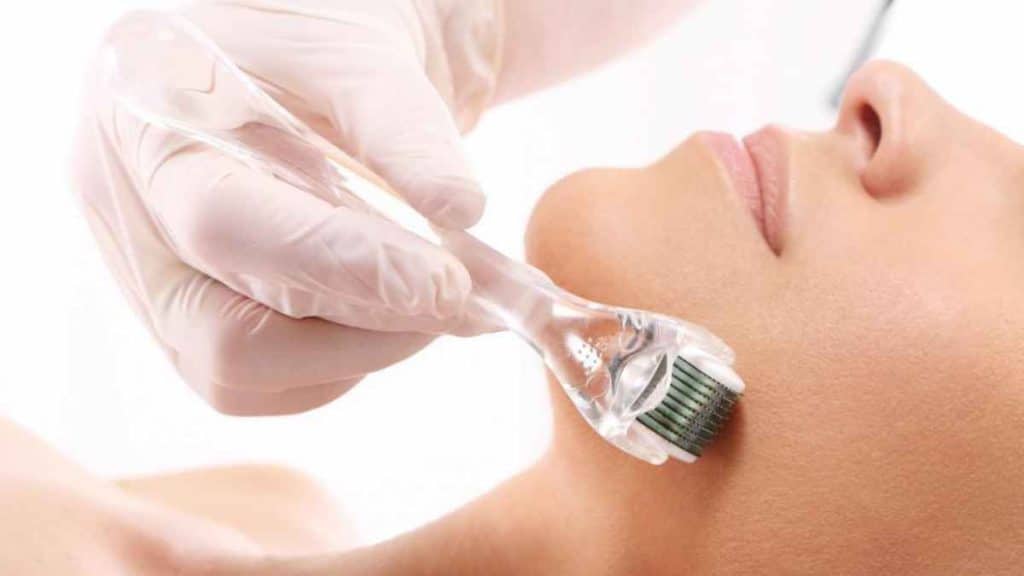Do you ever wonder why estheticians keep talking about microneedling in their Instagram posts and blogs? Is it a fad? Is it painful? Can I do it at home? Won’t it make scars? Why would anyone want to put needles in their skin?
Microneedling can seem like an overly simplified way to do a facial. However, there is science to back up this method of rejuvenating and toning the dermal layers to create more youthful looking skin.
What is microneedling used for?
Microneedling is a skin solution to help reduce signs of:
- Acne scars
- Surgical scars
- Stretch marks
- Aging
- Large pores
- Hyperpigmentation
How does microneedling work?
There are different forms that microneedling can take. However, all of them involve puncturing the skin with very small, very thin sets of needles. They can come in square or circular patches on their instrument heads. They can involve one needle poke at a time, or several.
Another phrase to describe microneedling is “collagen induction therapy.” This is because the teeny, tiny needle pokes in the skin force it to start the healing process. When it heals, the skin produces more collagen. Collagen is the protein that gives skin its bouncy texture, which is associated with youthfulness. We lose collagen as we age. So, boosting collagen can help restore skin’s health in our older years. This process is called “dermal remodeling.”
Old skin can look dull and loose. Scarred skin is skin that has healed unevenly. Microneedling, when performed over repeat sessions, can help reduce the effects of aging and wounded skin by producing new skin, which is essentially made up of collagen.
Why is microneedling popular?
There are many ways to rejuvenate the skin by kick-starting the dermal remodeling process. However, some of these methods can require quite a bit of downtime, depending on how deeply they penetrate the skin. Other methods may also rely on removing too much of the top layers of skin. This can make them harder to tolerate, in terms of pain.
On the flip side, other rejuvenation techniques only focus on the top layers of the dermis. This means they can’t reach deeply into the skin where some root problems lie, like acne scars.
While microneedling is not painless, it hurts much less than other more dramatic ways of rejuvenating the skin. It also comes with less downtime while reaching the dermis (lower layer of skin). This is why it is so popular.
However, because it is less intense, it can require multiple sessions, on a regulated schedule, to begin to see results.
What is RF microneedling?
RF microneedling refers to “radio-frequency microneedling.” It adds heat from radio-frequency to the process of microneedling. The heat destroys more cells beneath the top layer of skin, so that the body replaces them with even more new, fresh collagen. This helps increase the effectiveness of microneedling. Heat brings microneedling closer to the treatment of a laser facial. However, it is still not as strong.
Where can microneedling be done on the body?
Microneedling can be done on nearly any part of the body. However, it is mostly performed on the face, since that is where most people care to improve their appearance. That said, it can also be done on the neck, arms, hands, legs, back and stomach.
What are the side effects of microneedling?
Microneedling has few side effects. However, it can cause redness, swelling and flaking for a few days. That said, you can wear makeup about a day after the procedure.
In extreme cases, microneedling can temporarily worsen acne or cold sores. It can also cause infection. However, a medically-run clinic performing a microneedling procedure should be taking precautions to avoid these issues, or treat them afterwards.
No one should undergo microneedling if they have an active cold sore.
Can microneedling be done at home?
There are pseudo microneedling tools meant for home use, called derma rollers. These devices are not meant to go deep into the skin, the way that professional machinery does. They may only affect the epidermis (the topmost layer of skin). They also shouldn’t be used around sensitive areas, such as around the eyes.
Using an unsanitized derma roller can also spread infection or oral herpes. Thus, it is highly advised to trust professionals to do this type of job.
Should I get microneedling?
Whether or not microneedling is right for you should be decided by a professional aesthetician or doctor. Depending on your skin’s condition, or the severity of the problem you want to treat, different solutions may be best. Or, microneedling may be perfect.
Professionals with many tools in their arsenal of treatments can tailor skin treatments specifically for your needs. For example, they may suggest stronger treatments in the beginning, such as deep chemical peels or laser resurfacing. Then they may recommend a series of scheduled microneedling sessions afterwards. Or, they may recommend lighter treatments of mild chemical peels or mild laser peels.
It all depends on your needs, and not a cookie-cutter set of rules that apply to everyone.

